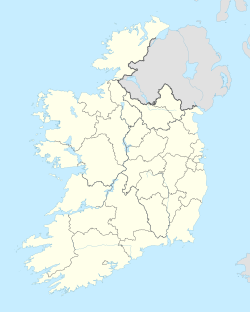world.wikisort.org - Ireland
Bruree (Irish: Brú Rí, meaning 'abode of kings')[2] is a village in south-eastern County Limerick, Ireland, on the River Maigue. It takes its name from the nearby ancient royal fortress, the alternative name of which from the earliest times into the High Middle Ages was Dún Eochair Maigue or the "fortress on the brink of the maigue". Other very old spellings and names include Brugh Righ, and Brugh Ri; literally, Brugh=Fort[citation needed] and Rí=King.
Bruree
Brú Rí | |
|---|---|
Village | |
 River Maigue at Bruree | |
 Bruree Location in Ireland | |
| Coordinates: 52°25′27″N 8°39′43″W | |
| Country | Ireland |
| Province | Munster |
| County | County Limerick |
| Government | |
| • Dáil Éireann | Limerick County |
| Population (2016)[1] | 580 |
| Time zone | UTC+0 (WET) |
| • Summer (DST) | UTC-1 (IST (WEST)) |
| Area code(s) | 063 |
Location
The village of Bruree is located on the Maigue river two kilometres off the main N20 Limerick-Cork road in south County Limerick. It forms one half of the parish of Bruree/Rockhill in the Diocese of Limerick. Bruree is seven kilometres north-west of Kilmallock, ten kilometres north of Charleville and thirty-five kilometres south of Limerick City. Neighbouring towns and villages include Kilmallock, Charleville, Effin, Athlacca, Banogue and Ballyagran.
History
Bruree was once a seat and alternative capital of the ancient Kings of Munster. At some point later it came into the possession of the Uí Fidgenti and was their capital until the late 12th century. Before them it may have belonged to the Dáirine or Érainn, being named by Geoffrey Keating as a fortress built by Cú Roí mac Dáire. An early king and semi-mythological ancestor of the Eóganachta and Uí Fidgenti, Ailill Aulom, is then found at the fortress in the Cath Maige Mucrama cycle. The historical Eóganacht king Óengus mac Nad Froích is also found here in one legend.

On the 26 August, a month after the 1919 - 1921 Irish War of Independence ended, workers in Bruree, seized the mill they worked in and hoisted the red flag over the building & hung a banner over the building proclaiming "Bruree Workers Soviet Mills – We Make Bread Not Profits". The soviet lasted until 3 September 1921.[3] This was one of over a 100 soviets that popped up in Ireland during the War of Independence and the Civil War, the most notable of which was the Limerick Soviet
The village also played a role in the Irish Civil War during the Battle of Kilmallock.
Sport
As in much of County Limerick, the main sport in Bruree is hurling, but Gaelic and association football are also played.
The Gaelic Athletic Association club in the parish is Bruree GAA which is a member of the south division of Limerick GAA. The club concentrates on hurling, but Gaelic football is also played. Bruree have won the Limerick Senior Hurling Championship on two occasions in 1893 and 2006 when they beat Patrickswell in the final.
The footballers of Bruree won the County Junior Football Championship in 2010 and reached the Munster final where they were beaten by St. Mary's Cahirciveen of County Kerry. They were relegated from the intermediate grade in 2012 and play at the junior grade.
People
- Catherine Coll, the mother of President of Ireland Éamon de Valera, was from Bruree and he was taken by her family to be raised here. De Valera's Cottage is a National Monument in the Knockmore townland.
- Very Reverend Eugene Sheehy was parish priest here[citation needed] in the early 1890s and had a huge influence on De Valera,[citation needed] who served as an altar boy in Bruree Church, during that period.[citation needed]
See also
- List of towns and villages in Ireland
References
- "Census 2016 - Sapmap Area - Settlements - Bruree". Census 2016. Central Statistics Office. 2016. Retrieved 12 August 2019.
- "Brú Rí / Bruree". logainm.ie. Irish Placenames Commission. Retrieved 12 August 2019.
- "Irish Soviets 1919-23". 8 October 2012.
Другой контент может иметь иную лицензию. Перед использованием материалов сайта WikiSort.org внимательно изучите правила лицензирования конкретных элементов наполнения сайта.
WikiSort.org - проект по пересортировке и дополнению контента Википедии
